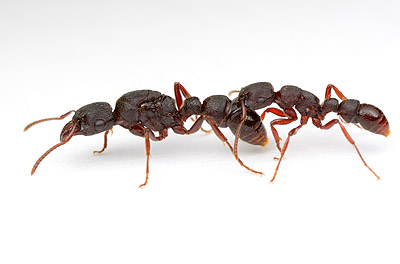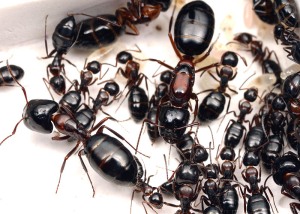
Ant queens are those individuals in a nest that lay the eggs. They're pretty important, of course, as without reproduction the colony dwindles and disappears.
Understandably, ant-keepers have an interest in making sure their pet colonies have queens. Conversely, pest control folks trying to get rid of ant colonies need to be sure that they've eliminated queens. Whether your interest is live ants or dead ants, I'll give some pointers in this post for recognizing queens.
In many species the difference between workers and queens is obvious. Consider the massive leafcutter queen pictured above who dwarfs her worker offspring. But the difference is frequently subtler, especially in species with many sizes of worker, or those with queens about the same size (or even smaller!) than workers. There are better ways than just size.
The key is understanding one important point: in most species, queens can fly during at least part of their adult life. Queens are born with wings, and they use them to leave their natal colony for mating and dispersal. Even after queens drop their wings they retain all the external machinery associated with flight. Most noticeable are the large muscles in the thorax and the wing attachment points.
Consequently, the easiest identification distills to this: queens have a larger thorax composed of more parts. I'll walk through an example below.

Gnamptogenys mordax queen and worker, Venezuela
Let's zoom in for a closer look. I've used photoshop to color the corresponding parts of the thorax similarly for both castes: prothorax (blue), mesothorax (yellow), metathorax (red), and propodeum (green).


Notice the extensive yellow band in the queen photo. This is the middle section of the thorax, the segment that once supported the main flight wings. It is packed with muscle, greatly expanded, taking up more than half the surface area. The segment supporting the smaller hind wings (in red), while not so large, forms a narrow band across the back. Visible along the sides of the top of these two segments are the wing attachments, looking a bit ragged with fragments of the wings still sticking out.
As you can see, the corresponding segments in the lower photo are scarcely noticeable. The mesothorax is reduced to a blip, and the metathorax is entirely sunk beneath the propodeum.

To test your skills, see if you can tell the queen from similarly-sized major workers in the photo at left (click on the photo to enlarge). She'll be the one with the more complex thorax.
Some caveats.
This method of counting thoracic sclerites only works for species with winged queens. This covers most ants, but as in all things there are exceptions. The army ant queens also have a reduced thorax to accompany their flightless lifestyle, but they tend to be large enough that identification is obvious. A few species of predatory ants- Dinoponera is a classic case- don't even have a differentiated queen caste. All the females in the nest look like workers with a small thorax. Recognizing who is reproducing in those species requires dissection to check the ovaries.
Male ants also have wings, so they might be confused with the young winged queens. But males tend to look much more slender and wasp-like, with small heads and bulbous eyes.
Finally, a word for you social insect professionals who are reading and cringing at my willy-nilly use of the term "queen". Yes, I know there are terminological issues surrounding the words gyne, alate, queen, and what have you for the distinctions of female morphology and behavior. But that level of complexity is probably counter-productive for an introduction to identification. Perhaps another post.
Additional resources:
update: Roberto Keller corrected the notal arrangement in the queen photo
- Log in to post comments

Good stuff! :)
Alex
Great photoshop job on the queen and worker thoracic morphology. I will venture a prediction that those photographs might just become a classic illustration in a future textbook on social insects.
Another sure fire way of identifying the queen among the workers is also very clear in evidence in your first image of the Atta texana queen. All flying queens have very obvious ocelli - those three little single eyes on the 'forehead'. Those are absent in workers since the ocelli, in most flying insects, are a key component in maintaining flight stability eg. the ocelli aide in determining the horizon while the insects are on the wing. Classic experiments have shown flying insects with their ocelli covered to be unable to fly 'upright' - in their attempts to fly their inability to determine the horizon results in them literally spiralling out of control either hitting easily avoidable obstacles or just crashing into the ground.
What an ideal article for amateurs! I totally didn't know that... thanks so much!
Actually some worker ants - e.g. all of Formicinae subfamily, like common Formica, Lasius or Camponotus - also have ocelli. They are probably evolutionary remnants with little function.
yawa
uh guys how do i know if i have a queen ? and + my ants in my farm the minute i put them in the ant farm u wanna know what they done they.... started building!! does this mean... i have a queen please somebody let me know because white stuff is always appearing in big clutters.. its been cloggin up their tunnles but they just put it somewhere else then when ever its windy they go inside the i go in the house if u know my questions please EMAIL ME AT PITAKEETPHONIX@AOL.COM
Fantastic articles, but good lord! That Queen Atta texana is unbelievable. I hope to see one some day.
Keep up the great work.
Thank you for your help!
Thanks for helping me identify my ant, she's a real beauty with her black body and red-orange legs and pincers and that part about her size was really helpful, she's about 2-3cm big, what a whopper!
thanks mate your pal Laura
one more thing, I'm not totally sure what kind of ant she is can you please help me!? email me please! really appreciated
your pal Laura
Thanks to your website i can find queen ant's and now i can see if i have a queen ant in my ant farm!:-)